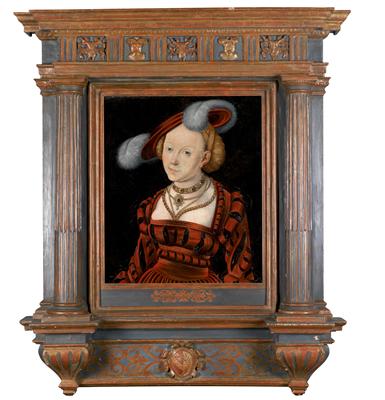Circle of Lucas Cranach the Elder (Kronach 1472–1553 Wittenberg)

The biblical Judith as a princess of the Renaissance, oil on panel, 62 x 52.5 cm, probably contemporary Tuscan tabernacle frame
Provenance:
European private collection.
Literature:
Dürer Van Dyck Warhol – Das inszenierte Porträt seit 1300, Petersberg 2006, p. 96. Exhibited: Dürer Van Dyck Warhol – Das inszenierte Porträt seit 1300, Überlingen 2006, no. II.1.
In the catalogue that accompanied the exhibition in Überlingen, where the present portrait was presented as a work by Lucas Cranach the Elder and his workshop, the picture is described as follows: “This female allegory illustrates that the stereotype of the femme fatale was already valid in the Renaissance, although the cliché may have been better known then as ‘female cunning’. An opulently adorned and luxuriously dressed lady looks at the spectator seductively. In her contemporary and strikingly fashionable attire, she resembles the portraits Cranach painted of the Saxon Duchess Sibylle of Cleve. It can thus not be entirely excluded that this is a portrait of the duchess in the role of the virtuous Judith, even if the present sitter’s physiognomy clearly differs from that of the duchess’s secured portraits. In terms of the motif, the panel presented here is most closely related to Cranach’s Judith in Aschaffenburg. The present painting has been trimmed significantly at the lower margin, for originally the female beauty presented a cut-off head; the lost fragment has meanwhile resurfaced on the art market, so that the woman depicted here has to be identified as a character from the Bible – either as Judith or as Salome. Probably the painter has deliberately left it to the viewers whether they wished to identify the beautiful woman as Judith – an example of virtue – or as the perfidious Salome. No matter whether the figure personifies Judith or Salome – in each case the picture is an elaborate and resourceful reflection upon the power of female seductiveness. Thus the picture fits in with the tradition of allegories of ‘female cunning’, similar to the legend of Aristotle and Phyllis. In a certificate of 1971, Leo Cremer, the former curator of Netherlandish painting at the Alte Pinakothek in Munich, considered the painting to likely be an autograph work by Lucas Cranach the Elder. Today it has to be assumed that the portion executed by workshop collaborators may be larger than previous Cranach experts believed…”
Specialist: Dr. Alexander Strasoldo
 Dr. Alexander Strasoldo
Dr. Alexander Strasoldo
+43-1-515 60-556
alexander.strasoldo@dorotheum.at
17.10.2012 - 18:00
- Realized price: **
-
EUR 99,500.-
- Estimate:
-
EUR 100,000.- to EUR 150,000.-
Circle of Lucas Cranach the Elder (Kronach 1472–1553 Wittenberg)
The biblical Judith as a princess of the Renaissance, oil on panel, 62 x 52.5 cm, probably contemporary Tuscan tabernacle frame
Provenance:
European private collection.
Literature:
Dürer Van Dyck Warhol – Das inszenierte Porträt seit 1300, Petersberg 2006, p. 96. Exhibited: Dürer Van Dyck Warhol – Das inszenierte Porträt seit 1300, Überlingen 2006, no. II.1.
In the catalogue that accompanied the exhibition in Überlingen, where the present portrait was presented as a work by Lucas Cranach the Elder and his workshop, the picture is described as follows: “This female allegory illustrates that the stereotype of the femme fatale was already valid in the Renaissance, although the cliché may have been better known then as ‘female cunning’. An opulently adorned and luxuriously dressed lady looks at the spectator seductively. In her contemporary and strikingly fashionable attire, she resembles the portraits Cranach painted of the Saxon Duchess Sibylle of Cleve. It can thus not be entirely excluded that this is a portrait of the duchess in the role of the virtuous Judith, even if the present sitter’s physiognomy clearly differs from that of the duchess’s secured portraits. In terms of the motif, the panel presented here is most closely related to Cranach’s Judith in Aschaffenburg. The present painting has been trimmed significantly at the lower margin, for originally the female beauty presented a cut-off head; the lost fragment has meanwhile resurfaced on the art market, so that the woman depicted here has to be identified as a character from the Bible – either as Judith or as Salome. Probably the painter has deliberately left it to the viewers whether they wished to identify the beautiful woman as Judith – an example of virtue – or as the perfidious Salome. No matter whether the figure personifies Judith or Salome – in each case the picture is an elaborate and resourceful reflection upon the power of female seductiveness. Thus the picture fits in with the tradition of allegories of ‘female cunning’, similar to the legend of Aristotle and Phyllis. In a certificate of 1971, Leo Cremer, the former curator of Netherlandish painting at the Alte Pinakothek in Munich, considered the painting to likely be an autograph work by Lucas Cranach the Elder. Today it has to be assumed that the portion executed by workshop collaborators may be larger than previous Cranach experts believed…”
Specialist: Dr. Alexander Strasoldo
 Dr. Alexander Strasoldo
Dr. Alexander Strasoldo
+43-1-515 60-556
alexander.strasoldo@dorotheum.at
|
Buyers hotline
Mon.-Fri.: 10.00am - 5.00pm
old.masters@dorotheum.at +43 1 515 60 403 |
| Auction: | Old Master Paintings |
| Auction type: | Saleroom auction |
| Date: | 17.10.2012 - 18:00 |
| Location: | Vienna | Palais Dorotheum |
| Exhibition: | 06.10. - 17.10.2012 |
** Purchase price incl. charges and taxes
It is not possible to turn in online buying orders anymore. The auction is in preparation or has been executed already.
